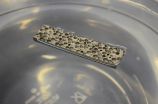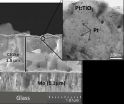(Press-News.org) BUFFALO, N.Y. -- Tinnitus is the most common service-related disability for veterans returning from Iraq and Afghanistan. Often described as a ringing in the ears, more than 1.5 million former service members, one out of every two combat veterans, report having this sometimes debilitating condition, resulting in more than $2 billion dollars in annual disability payments by the U.S. Department of Veterans Affairs.
Tinnitus is largely a mystery, a phantom sound heard in the absence of actual sound. Tinnitus patients "hear" ringing, buzzing or hissing in their ears much like an amputee might "feel" pain in a missing limb. It is a symptom, not a disease, and though exposure to loud noise may cause it, some cases have no apparent trigger.
Existing treatments, meantime, are unreliable, either not working at all or varying greatly in effectiveness for those who report some relief.
But a global research effort involving investigators from the University at Buffalo; Southeast University in Nanjing, China; and Dalhousie University in Nova Scotia, Canada, have made a major breakthrough that provides new insights into how tinnitus, and the often co-occurring hyperacusis, a condition that causes sounds to be perceived as intolerably loud, might develop and be sustained.
The results of the study, to be published in a forthcoming edition of eLife, suggest the neural network responsible is more expansive than previously thought. The findings could lead to a testable model that helps to identify what region or regions of the brain might be responsible for causing the two conditions.
Having conceptualized a broader, more comprehensive neural network, the researchers hope to eventually test the model by deactivating specific segments of the neural network. By process of elimination they would learn if shutting down one part of that network relieves tinnitus, hyperacusis or both conditions.
Until the mid-1990s, tinnitus was thought to be centered in the ear, but patients who lost their hearing on one side after a surgical tumor removal unrelated to the condition reported still hearing a ringing -- in their deaf ear.
"This changed the thinking in the field," says Richard Salvi, director of UB's Center for Hearing and Deafness, and one of the study's authors. "Having severed the neural connection between the ear and the brain, it's impossible for the phantom sound to be generated in the ear. It has to be generated in the brain."
Though it's not known yet exactly where and how tinnitus occurs in the brain, Salvi says their functional MRI studies show the abnormal activity underlying tinnitus and hyperacusis isn't confined to a specific brain location, but actually involves a neural network.
Unlike traditional MRIs, which show only structure, functional MRIs show what parts of the structure are active at a given time while functional connectivity MRI reveals how one part of the brain interacts with other regions, much like partners would interact on a dance floor, explains Yu-Chen Chen, a radiologist at Southeast University and one of the study's co-authors.
The researchers induced tinnitus in rats by administering the active ingredient in aspirin, which has long been known to produce tinnitus and hyperacusis symptoms in humans.
"Certain brain regions become very active once tinnitus is induced, much more so than it is for an animal with normal hearing," says Salvi. "Even though high-dose aspirin induces a hearing loss and less information is being sent from the ear to the brain as a result, the brain responds with greater activity. It's paradoxical, like a car getting better gas mileage with a less efficient engine."
Tracing the network's course, the investigators identified a major hub within the central auditory pathway, the sound processing center of the brain.
"Other research has shown this activity, but what is novel about the current study is the amygdala pops up. This is the part of the brain that assigns emotion to our perceptions," says Salvi. "Many patients report the onset of tinnitus after experiencing significant stress or anxiety. We think it's not just the hearing loss that's essential. There are other emotional factors working together with the auditory factors."
The reticular formation, an arousal center involved in the "fight or flight" response is active too, plus the hippocampus, the memory region of the brain that helps identify where things are located, such as the location of the phantom sound.
So the auditory system is connecting sound to a location, the ear in this case. There is emotion and arousal, but the final puzzling piece to the network is activity in the cerebellum, normally activated during motor planning events like reaching for a cup or catching a ball.
"We were shocked when this part of the brain popped up," says Salvi. "Almost all parts of the network can be explained: location of sound; the emotional attachment; why people get aroused when they have tinnitus; we're puzzled by the cerebellum involvement, but it might act like some kind of "gate" that's allowing the phantom sound to enter the consciousness," says Salvi.
INFORMATION:
Transgenic Huntington's disease monkeys show similarity to humans with Huntington's in their progressive neurodegeneration and decline of motor control, scientists from Yerkes National Primate Research Center, Emory University, report.
These findings are promising for developing a preclinical, large animal model of Huntington's disease for assessing new therapeutics, which could ultimately provide better treatment options, including altering the course of the disease.
In this first multiyear study on a transgenic nonhuman primate model for Huntington's, lead author ...
DURHAM, N.C. -- Lemur girls behave more like the guys, thanks to a little testosterone, according to a new study.
Males rule in most of the animal world. But when it comes to conventional gender roles, lemurs -- distant primate cousins of ours -- buck the trend.
It's not uncommon for lady lemurs to bite their mates, snatch a piece of fruit from their hands, whack them in the head or shove them out of prime sleeping spots. Females mark their territories with distinctive scents just as often as the males do. Males often don't take their share of a meal until the females ...
BROOKLYN, New York -- Researchers have demonstrated a new metal matrix composite that is so light that it can float on water. A boat made of such lightweight composites will not sink despite damage to its structure. The new material also promises to improve automotive fuel economy because it combines light weight with heat resistance.
Although syntactic foams have been around for many years, this is the first development of a lightweight metal matrix syntactic foam. It is the work of a team of researchers from Deep Springs Technology (DST) and the New York University ...
The sun was just beginning to rise as two men headed down to the beach to board a small inflatable boat. Searching for abalone was on their agenda for the day. Their excitement was difficult to contain as they surveyed the coastline looking for sand ridges -- an important clue that abalone may be near. The two men, David Witting and Bill Hagey, share a passion for finding the now rare white abalone and understanding the movement and feeding behaviors of all abalone species.
David Witting, a NOAA Fisheries biologist, has been engaged in efforts to restore abalone populations ...
Many of us are familiar with electrolytic splitting of water from their school days: if you hold two electrodes into an aqueous electrolyte and apply a sufficient voltage, gas bubbles of hydrogen and oxygen are formed. If this voltage is generated by sunlight in a solar cell, then you could store solar energy by generating hydrogen gas.This is because hydrogen is a versatile medium of storing and using "chemical energy". Research teams all over the world are therefore working hard to develop compact, robust, and cost-effective systems that can accomplish this challenge. ...
For the first time, a researcher at the University of Waterloo has theoretically demonstrated that it is possible to detect a single nuclear spin at room temperature, which could pave the way for new approaches to medical diagnostics.
Published in the journal Nature nanotechnology this week, Amir Yacoby from the University of Waterloo, along with colleagues from University of Basel and RWTH Aachen University, propose a theoretical scheme that could lead to enhanced Nuclear Magnetic Resonance (NMR) imaging of biological materials in the near future by using weak magnetic ...
TORONTO, ON -- "Cloudy for the morning, turning to clear with scorching heat in the afternoon."
While this might describe a typical late-summer day in many places on Earth, it may also apply to planets outside our solar system, according to a new study by an international team of astrophysicists from the University of Toronto, York University and Queen's University Belfast.
Using sensitive observations from the Kepler space telescope, the researchers have uncovered evidence of daily weather cycles on six extra-solar planets seen to exhibit different phases. Such phase ...
In a new study published in the Protein & Cell, Chen-Yu Zhang's group at Nanjing University reports that small non-coding RNAs in maternal food can transfer through placenta to regulate fetal gene expression.
MicroRNAs (miRNA) are a class of noncoding RNAs with lengths of approximately 22 nucleotides that bind to target messenger RNAs to inhibit protein translation. In previous studies, the same group has found that plant miRNAs can enter into the host blood and tissues via the route of food-intake. The food-derived exogenous miRNAs are absorbed, packaged into microvesical ...
WASHINGTON, DC -- May 12, 2015-- A multidisciplinary group of US-based researchers has shown that the mixture of species found within natural bacterial communities in the environment can accurately predict the presence of contaminants such as uranium, nitrate, and oil. The findings, published this week in mBio, the online open-access journal of the American Society for Microbiology, show that the rapid sequencing of microbiomes in place at environmental sites can be used to monitor damage caused by human activity.
"This approach might be a general way for us to see anthropogenic ...
Nerve cells that produce dopamine for the purpose of transmitting signals to other cells affect numerous crucial brain functions. This becomes evident in diseases such as Parkinson's and schizophrenia, where dopamine transmission in the brain is impaired. In collaboration with researchers from Bonn, RUB scientists at the Mercator Research Group "Structure of Memory" have now identified in what way a specific form of this important cell is generated and which networks it forms in the course of brain development. In the process, the researchers discovered a data highway of ...



